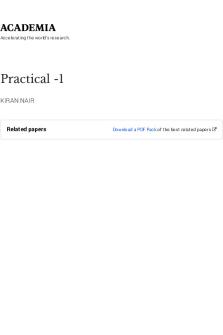Aim - PRACTICAL WORK 1: PORTER GOVERNOR (Semester 1, 2019) 1. Aims The aims of this PDF

| Title | Aim - PRACTICAL WORK 1: PORTER GOVERNOR (Semester 1, 2019) 1. Aims The aims of this |
|---|---|
| Author | Thabang Lehetla |
| Course | Theory of Machines III |
| Institution | Central University of Technology |
| Pages | 10 |
| File Size | 313.1 KB |
| File Type | |
| Total Downloads | 46 |
| Total Views | 156 |
Summary
PRACTICAL WORK 1: PORTER GOVERNOR (Semester 1, 2019)
1. Aims
The aims of this practical work are:
i. To investigate the variation of the radius of rotation of the fly balls with the vertical movement of the sleeve.
ii. To investigate the variation of the rotational speed...
Description
Table of contents Page
1. Aim, Apparatus
1
2. Theory, Experimental procedure
2
3. Experimental results
3
4. Calculations
4
5. Tabulated results
8
6. Conclusion, References
9
Aim
To study the variation of the fly balls ' rotation radius r with the sleeve's vertical movement y. To explore the variation of the governor's rotational speed by changing the sleeve's vertical motion y To explore the variation in the governor's rotational speed by changing the governor's height h
Sketch of the apparatus
Figure 1 Porter Governor (Courtesy MTM32AI Lab Guide)
The component with the fly balls, arms, links and the central dead weight is the Porter governor and is the main focus of the experiment as outlined in the aim of the investigation. The mass hanger on the left of the governor serves the purpose of adding load to the governor. The speed adjustment screw allows the operator to change the speed of the electric motor running the governor.
Summary of theory A governor's purpose is to regulate an engine's mean speed when there are variations. When the load increases, the governor's configuration changes and a valve is raised to raise the supply of the working fluid; conversely, when the load lowers the engine velocity rises and the governor lowers the supply of working fluid. The aim of the centrifugal governors is to balance the centrifugal force on the rotating balls by an equal and opposite radial force. As the demand on the engine grows, the centrifugal force on the balls lowers. A governor monitors the velocity of the engine. As it rotates, the weights swing outward, pulling down a spindle that reduces the fuel supply at high velocity. Governors have a variety of applications in industry and these are some of the more common applications: In thermal power generation, governors serve the purpose of opening or closing of the steam control valve in order to reduce or increase the amount of steam going into a turbine, this increases or reduces the speed of rotation of the generating turbine to a pre-set value. Experimental Procedure
1. Add additional weight P1 onto the hanger 2. Start electrical motor of the Porter governor and let the speed gradually increase until the sleeve with the central mass M just begins to lift from its zero position. 3. Record the governor speed for that position. For accurate readings, the speed must be kept constant for at least 10 seconds before the reading is recorded. 4. From 0 to 50 mm, for each increment of 5 mm of the vertical movement of the sleeve, record the governor speed 5. After recording of the speed governor for the sleeve lift of 50 mm from the zero position, switch off the electrical motor of the governor. 6. Add additional weight P2 onto the hanger 7. Repeat steps 2 to 4
Experiment results
Arm length = 125 mm
Dead weigh mass = 25 N
Link length = 125 mm
Fly balls mass = 5 N
Eccentricity = 25 mm
B = 225 mm
Sleeve movement y (mm)
Additional weight P1 (N)
Additional weight P2
Governor rotation speed n (rpm)
Governor rotation speed n (rpm)
0
202
215
5
210
218
10
213
223
15
220
224
20
225
226
25
227
229
30
232
237
35
236
241
40
238
245
45
241
253
50
249
258
(N)
Calculations and graphs Using the sketch below
Figure 2 (Courtesy MTM32AI Lab Guide)
Case 1 Y=0 mm 𝐶𝐷 =
𝑏 − 𝑦 225 − 0 = 112.5 𝑚𝑚 = 2 2
𝐵𝐶 = √𝐴𝐵2 + 𝐴𝐶 2 = √1252 + 112.52 = 54 .486 𝑚𝑚 𝑟 = 𝐵𝐶 + 𝑒 = 54.486 + 25 = 79.486 𝑚𝑚
Σ𝑀𝐼 = 0 (𝐴𝑛𝑡𝑖𝑐𝑙𝑜𝑐𝑘𝑤𝑖𝑠𝑒 +) 𝑚𝑟𝜛 2 (𝐵𝑀) = 𝑊(𝐼𝑀) + (
𝑀𝐺 𝑃 + ) (𝐼𝐷) 2 4
(0.510)(79.486 × 10−3 )𝜔2 (112.5 × 10 −3 ) 25 5 = 5(54.486 × 10−3 ) + ( + ) (108.97 × 10 −3 ) 2 4 ∴ 𝜔 = 19.704 ℎ=
𝑟𝑎𝑑𝑠 𝑠
𝑟(𝑏 − 𝑦) 79.486(225 − 0) = 164.119 𝑚𝑚 = 2(𝑟 − 𝑒) 2(79.486 − 25)
Y=5 mm 𝐶𝐷 =
𝑏−𝑦 2
=
225 − 5 = 110 𝑚𝑚 2
𝐵𝐶 = √𝐴𝐵2 + 𝐴𝐶 2 = √1252 + 1102 = 59.372 𝑚𝑚 𝑟 = 𝐵𝐶 + 𝑒 = 59 .375 + 25 = 84.372 𝑚𝑚
Σ𝑀𝐼 = 0 (𝐴𝑛𝑡𝑖𝑐𝑙𝑜𝑐𝑘𝑤𝑖𝑠𝑒 +) 𝑚𝑟𝜛 2 (𝐵𝑀) = 𝑊(𝐼𝑀) + (
𝑀𝐺 𝑃 + ) (𝐼𝐷) 4 2
(0.510)(84.372 × 10−3 )𝜔2 (110 × 10−3 ) 25 5 = 5(59.372 × 10−3 ) + ( + ) (118.744 × 10−3 ) 4 2 ∴ 𝜔 = 20.191 ℎ=
𝑟𝑎𝑑𝑠 𝑠
𝑟(𝑏 − 𝑦) 84.372(225 − 5) = 156.318 𝑚𝑚 = 2(𝑟 − 𝑒) 2(84.372 − 25)
Y=10 mm 𝐶𝐷 =
𝑏 − 𝑦 225 − 10 = 107.5 𝑚𝑚 = 2 2
𝐵𝐶 = √𝐴𝐵2 + 𝐴𝐶 2 = √1252 + 107.52 = 63 .787 𝑚𝑚 𝑟 = 𝐵𝐶 + 𝑒 = 63 .787 + 25 = 88.787 𝑚𝑚
Σ𝑀𝐼 = 0 (𝐴𝑛𝑡𝑖𝑐𝑙𝑜𝑐𝑘𝑤𝑖𝑠𝑒 +) 𝑚𝑟𝜛 2 (𝐵𝑀) = 𝑊(𝐼𝑀) + (
𝑀𝐺 𝑃 + ) (𝐼𝐷) 2 4
(0.510)(88.787 × 10−3 )𝜔2 (107.5 × 10 −3 ) 25 5 = 5(163.787 × 10 −3 ) + ( + ) (127.574 × 10 −3 ) 2 4 ∴ 𝜔 = 20.637 ℎ=
𝑟𝑎𝑑𝑠 𝑠
𝑟(𝑏 − 𝑦) 88.787(225 − 10) = = 149 .632 𝑚𝑚 2(𝑟 − 𝑒) 2(88.787 − 25)
Case 2 Y=0 mm 𝐶𝐷 =
𝑏 − 𝑦 225 − 0 = = 112.5 𝑚𝑚 2 2
𝐵𝐶 = √𝐴𝐵2 + 𝐴𝐶 2 = √1252 + 112.52 = 54 .486 𝑚𝑚
𝑟 = 𝐵𝐶 + 𝑒 = 54 .486 + 25 = 79.486 𝑚𝑚
Σ𝑀𝐼 = 0 (𝐴𝑛𝑡𝑖𝑐𝑙𝑜𝑐𝑘𝑤𝑖𝑠𝑒 +) 𝑚𝑟𝜛 2 (𝐵𝑀) = 𝑊(𝐼𝑀) + (
𝑀𝐺 𝑃 + ) (𝐼𝐷) 4 2
(0.510)(79.486 × 10−3 )𝜔2 (112.5 × 10 −3 ) 25 10 = 5(56.486 × 10−3 ) + ( + ) (108.472 × 10 −3 ) 4 2 ∴ 𝜔 = 20.449 ℎ=
𝑟𝑎𝑑𝑠 𝑠
𝑟(𝑏 − 𝑦) 79.486(225 − 0) = 164.119 𝑚𝑚 = 2(𝑟 − 𝑒) 2(79.486 − 25)
Y=5mm 𝐶𝐷 =
𝑏 − 𝑦 225 − 5 = 110 𝑚𝑚 = 2 2
𝐵𝐶 = √𝐴𝐵2 + 𝐴𝐶 2 = √1252 + 1102 = 59.372 𝑚𝑚 𝑟 = 𝐵𝐶 + 𝑒 = 59 .375 + 25 = 84.372 𝑚𝑚
Σ𝑀𝐼 = 0 (𝐴𝑛𝑡𝑖𝑐𝑙𝑜𝑐𝑘𝑤𝑖𝑠𝑒 +) 𝑚𝑟𝜛 2 (𝐵𝑀) = 𝑊(𝐼𝑀) + (
𝑀𝐺 𝑃 + ) (𝐼𝐷) 2 4
(0.510)(84.372 × 10−3 )𝜔2 (110 × 10−3 ) 25 10 = 5(59.372 × 10−3 ) + ( + ) (118.744 × 10 −3 ) 2 4 ∴ 𝜔 = 20.953 ℎ=
𝑟𝑎𝑑𝑠 𝑠
𝑟(𝑏 − 𝑦) 84.372(225 − 5) = = 156.318 𝑚𝑚 2(𝑟 − 𝑒) 2(84.372 − 25)
Y=10 mm 𝐶𝐷 =
𝑏−𝑦 2
=
225 − 10 = 107.5 𝑚𝑚 2
𝐵𝐶 = √𝐴𝐵2 + 𝐴𝐶 2 = √1252 + 107.52 = 63 .787 𝑚𝑚
𝑟 = 𝐵𝐶 + 𝑒 = 63 .787 + 25 = 88.787 𝑚𝑚
Σ𝑀𝐼 = 0 (𝐴𝑛𝑡𝑖𝑐𝑙𝑜𝑐𝑘𝑤𝑖𝑠𝑒 +) 𝑚𝑟𝜛 2 (𝐵𝑀) = 𝑊(𝐼𝑀) + (
𝑀𝐺 𝑃 + ) (𝐼𝐷) 4 2
(0.510)(88.787 × 10−3 )𝜔2 (107.5 × 10 −3 ) 25 10 = 5(163.787 × 10 −3 ) + ( + ) (127.574 × 10−3 ) 4 2 ∴ 𝜔 = 22.06 ℎ=
𝑟𝑎𝑑𝑠 𝑠
𝑟(𝑏 − 𝑦) 88.787(225 − 10) = 149 .632 𝑚𝑚 = 2(88.787 − 25) 2(𝑟 − 𝑒)
Tabulated results Additional weight P1 (N) Additional weight P2 (N) Sleeve moveme nt y (mm)
Radius of rotatio n
Height (mm)
Rotation speed 𝜔 of the Rotation speed 𝜔 of the governor (rad/s) governor (rad/s) Experiment Theoretic al al
Experiment al
Theoretic al
(mm) 0
79.486
164.11 9
202
19.704
215
20.449
5
84.372
156.31 8
210
20.191
218
20.953
10
88.787
149.63 2
213
20.637
223
22.06
15
92.823
143.70 4
220
21.058
224
21.853
20
96.545
138.31 7
225
21.464
226
22.275
25
100
133.33 3
227
21.862
229
22.687
30
103.22
128.66 1
232
22.255
237
23.095
35
106.24
124.23 4
236
22.648
241
23.503
40
81.24
106.24
238
22.648
245
23.503
45
84.076
109.07 6
241
23.474
253
23.914
50
114.26 8
112.00 5
249
23.853
258
24.33
Conclusion The first set of rotational speed vs fly ball radius graphs reveal a directly proportional relationship which is also right according to the theory summary as the fly ball radius increases with the governor's rising rotational speed. Again in this case, the theoretical and experimental graphs were mostly parallel to each other and this validates the theoretical formulae. The second set of rotational vs. governor height graphs demonstrates that these two variables are inversely proportional. For most of the graph, the theoretical and experimental paths are orthogonal and this confirms that the theoretical theorems are absolutely correct. The error in the experiment may be due to the following factors:
The sleeve friction that affect the speed readings and the fact that it wasn’t accounted for in the calculations. The measurement of the sleeve movement was done with the naked eye and this is not an accurate tool of measurement.
References Mechanics of Machines (Elementary Theory and Examples), 4th edition, Hannah J and Stephens R C, Edward Arnold, ISBN 0-7131-3471-2.
Theory of Machines, 14th revised edition, R.S Khurmi and J.K. Gupta, S. Chand, ISBN 81-219-2524-X MTM32BI Laboratory Guide, Ms. Olwagen...
Similar Free PDFs

1 Aims and values
- 4 Pages

Screenen en evalueren - AIMS
- 1 Pages

Abstract, Aims & Objectives
- 3 Pages

Money market aims and objectives
- 12 Pages

Work summary semester test 1
- 7 Pages

MTRX1701 2019 Semester 1 student
- 5 Pages

ENGG1111 2019 Semester 1 student
- 5 Pages

Practical -1
- 20 Pages
Popular Institutions
- Tinajero National High School - Annex
- Politeknik Caltex Riau
- Yokohama City University
- SGT University
- University of Al-Qadisiyah
- Divine Word College of Vigan
- Techniek College Rotterdam
- Universidade de Santiago
- Universiti Teknologi MARA Cawangan Johor Kampus Pasir Gudang
- Poltekkes Kemenkes Yogyakarta
- Baguio City National High School
- Colegio san marcos
- preparatoria uno
- Centro de Bachillerato Tecnológico Industrial y de Servicios No. 107
- Dalian Maritime University
- Quang Trung Secondary School
- Colegio Tecnológico en Informática
- Corporación Regional de Educación Superior
- Grupo CEDVA
- Dar Al Uloom University
- Centro de Estudios Preuniversitarios de la Universidad Nacional de Ingeniería
- 上智大学
- Aakash International School, Nuna Majara
- San Felipe Neri Catholic School
- Kang Chiao International School - New Taipei City
- Misamis Occidental National High School
- Institución Educativa Escuela Normal Juan Ladrilleros
- Kolehiyo ng Pantukan
- Batanes State College
- Instituto Continental
- Sekolah Menengah Kejuruan Kesehatan Kaltara (Tarakan)
- Colegio de La Inmaculada Concepcion - Cebu







